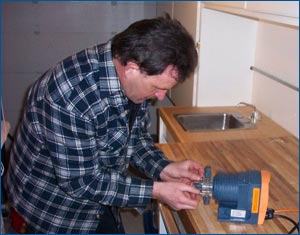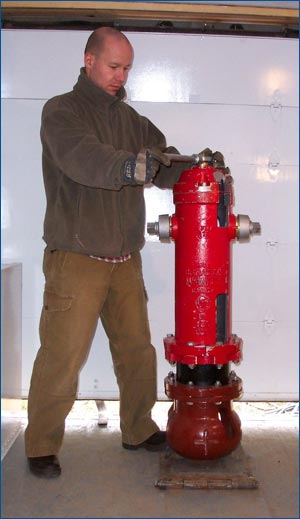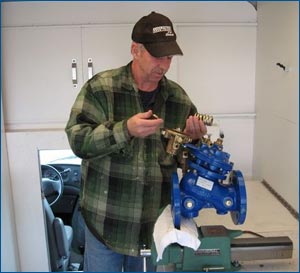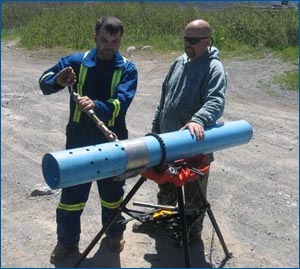The on-site training curriculum currently includes the following sessions:
Disinfection
- Primary and secondary disinfection principles
- Chlorine residual monitoring using colorimeter test kits
- CT factors
Hypo Chlorination
- General operation of chemical feed pump systems
- Required maintenance for chemical feed pumps
- Troubleshooting chemical feed pumps
- Solution mixing
- Hypochlorite titration testing

Gas Chlorination
- General operation of gas chlorination systems
- Maintenance of gas chlorination systems, including disassembly of an injector and vacuum regulator
- Self Contained Breathing Apparatus (SCBA) & full-faced cartridge air respirator
- Chlorine gas cylinder use and handling, including proper protocols for cylinder changeover
- Chlorine gas detection system testing
- Automatic switchover systems
Fire Hydrant Maintenance
- General operational theory for hydrants
- Maintenance of hydrants including drain ring plugging, valve cleaning and use of hydrant wrenches
- Dismantling of cutaway hydrant
- Conversion and extension kits
- Surge control

Control Valve Maintenance
- Function of control valves in a water distribution system
- Required maintenance including valve body cleaning
- Operation of sustaining and reducing pilot controls
- Dismantling of pressure reducing valve and pilot control system
- Dismantling of air relief valves

Pipe Tapping
- Introduction to installing service connections and curb stop replacements
- Direct tapping
- Saddle tapping
- Use of aqua stop repair tools
- Practical application of drilling & tapping equipment

Leak Detection
- Introduction to acoustic leak detection
- Practical application of various acoustic leak detectors
- Practical application of pipe location equipment
- Discussing water loss and factors affecting leakage
- Conducting hydrant surveys
Distribution System Flushing
- Fundamentals of creating and managing a unidirectional flushing program
- Creating a flushing schedule
- Monitoring system pressures and flows
- Analyzing a system’s capability of supporting a unidirectional flushing program
- Equipment requirements
- Identifying sensitive areas within the community
- Locating and exercising of mainline gate valves
pH Adjustment
- Definition of pH and the pH scale; difference between acids and bases and the purpose for maintaining pH in adherence with the Guidelines for Canadian Drinking Water
- Methods used to measure pH including equipment, accuracy, temperature effects, and calibration and maintenance of equipment
- Alternative methods of pH adjustment
- Injection of pH adjustment solutions (Solenoid Dosing Pumps or Dry Chemical Volumetric Feed Systems)
- Description of the types of chemicals used for pH adjustment
Flow Meters
- Introduction to common types of flow meters
- Basic operation and maintenance
- Installation, calibration and troubleshooting
- Flow meters and leak detection techniques
Gas Monitor Use (WWC)
- Overview of basic operation modes, settings and alarms
- Sensor zeroing and calibration
- Demonstration of the multi-gas testing
- Basic maintenance and repair
- Confined space overview
Rescue Systems (WWC)
- Installation and operation of retrieval rescue systems
- Installation and inspection of anchoring device
- Basic maintenance and repair of rescue systems
- Donning, use and inspection of personal protective equipment
- Confined space overview
